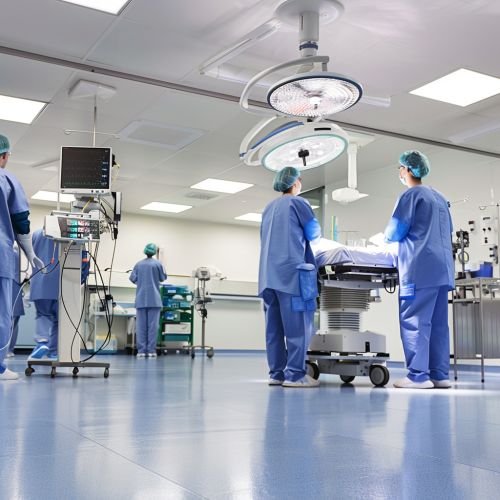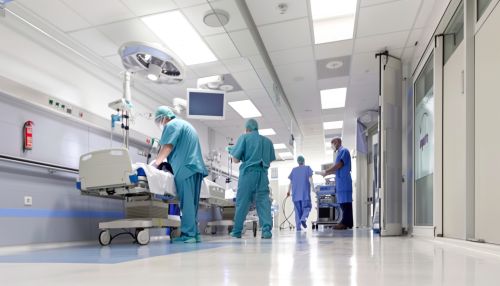Medical Industry: Difference between revisions
(Created page with "== Overview == The medical industry, also known as the healthcare industry, encompasses a wide range of sectors that provide goods and services to treat patients with curative, preventive, rehabilitative, and palliative care. This industry includes the generation and commercialization of goods and services that aid in the diagnosis, treatment, and management of diseases and health conditions. The medical industry is a critical component of the economy in many countries,...") |
No edit summary |
||
| Line 70: | Line 70: | ||
<references /> | <references /> | ||
[[Image:Detail-92083.jpg|thumb|center|Modern hospital interior with advanced medical equipment and healthcare professionals in action.|class=only_on_mobile]] | |||
[[Image:Detail-92084.jpg|thumb|center|Modern hospital interior with advanced medical equipment and healthcare professionals in action.|class=only_on_desktop]] | |||
Latest revision as of 07:01, 18 June 2024
Overview
The medical industry, also known as the healthcare industry, encompasses a wide range of sectors that provide goods and services to treat patients with curative, preventive, rehabilitative, and palliative care. This industry includes the generation and commercialization of goods and services that aid in the diagnosis, treatment, and management of diseases and health conditions. The medical industry is a critical component of the economy in many countries, contributing significantly to employment and economic growth.
Sectors of the Medical Industry
The medical industry is divided into several key sectors, each with its own specialized focus and functions. These sectors include:
Pharmaceuticals
The pharmaceutical sector is responsible for the development, production, and marketing of medications. This sector is heavily regulated to ensure the safety and efficacy of drugs. Major activities include drug discovery, clinical trials, regulatory approval, and marketing. Companies in this sector range from large multinational corporations to small biotech firms.
Medical Devices
The medical devices sector involves the design, manufacture, and sale of instruments and apparatuses used in medical procedures. This includes everything from simple tools like syringes and scalpels to complex machinery like MRI scanners and robotic surgical systems. The development of medical devices requires rigorous testing and regulatory approval to ensure they meet safety standards.
Healthcare Services
Healthcare services encompass a wide range of activities provided by hospitals, clinics, and other healthcare facilities. This sector includes primary care, specialized medical services, surgical procedures, and emergency care. Healthcare services are delivered by a variety of professionals, including doctors, nurses, and allied health workers.
Biotechnology
Biotechnology involves the use of living organisms and bioprocesses in engineering, technology, and medicine. This sector focuses on developing products and technologies for medical use, such as genetic testing, gene therapy, and personalized medicine. Biotechnology companies often work closely with academic institutions and research organizations.
Health Insurance
Health insurance is a critical component of the medical industry, providing financial protection against the high costs of medical care. Insurance companies offer various plans that cover different types of medical services, from routine check-ups to major surgeries. The health insurance sector is highly regulated to ensure that policies are fair and accessible to the public.
Research and Development
Research and development (R&D) is a cornerstone of the medical industry, driving innovation and advancements in medical science. R&D activities are conducted by pharmaceutical companies, medical device manufacturers, biotechnology firms, and academic institutions. These activities include basic research to understand disease mechanisms, applied research to develop new treatments, and clinical trials to test the safety and efficacy of new therapies.
Clinical Trials
Clinical trials are a critical phase in the development of new medical treatments. These trials are conducted in multiple phases to evaluate the safety, efficacy, and optimal dosing of new drugs or devices. Phase I trials test the safety of a treatment in a small group of healthy volunteers. Phase II trials assess the efficacy and side effects in a larger group of patients. Phase III trials involve a larger patient population to confirm the treatment's effectiveness and monitor adverse reactions. Phase IV trials are conducted after a treatment has been approved to gather additional information on its long-term effects.
Regulatory Framework
The medical industry is subject to stringent regulatory oversight to ensure the safety and efficacy of medical products and services. Regulatory agencies, such as the FDA in the United States and the EMA in Europe, are responsible for evaluating and approving new drugs, medical devices, and other healthcare products. These agencies establish guidelines for clinical trials, manufacturing practices, and post-market surveillance.
Good Manufacturing Practice (GMP)
Good Manufacturing Practice (GMP) is a system that ensures products are consistently produced and controlled according to quality standards. GMP covers all aspects of production, from raw materials to finished products. Compliance with GMP is mandatory for pharmaceutical and medical device manufacturers to ensure the safety and quality of their products.
Health Technology Assessment (HTA)
Health Technology Assessment (HTA) is a multidisciplinary process that evaluates the social, economic, organizational, and ethical issues of a health intervention or health technology. HTA provides policymakers with evidence-based information to make informed decisions about the adoption and reimbursement of new medical technologies.
Economic Impact
The medical industry has a significant economic impact, contributing to job creation, innovation, and economic growth. The industry is a major employer, providing jobs for millions of people worldwide, from researchers and healthcare professionals to manufacturing and administrative staff. The development of new medical technologies and treatments drives economic growth by improving health outcomes and increasing productivity.
Global Market
The global medical industry is a multi-trillion-dollar market, with significant growth driven by factors such as an aging population, increasing prevalence of chronic diseases, and advancements in medical technology. The United States, Europe, and Asia are major markets for medical products and services, with emerging markets in Latin America and Africa showing rapid growth.
Investment and Funding
Investment in the medical industry comes from various sources, including government funding, private investment, and venture capital. Governments invest in healthcare infrastructure and research to improve public health and stimulate economic growth. Private investors and venture capitalists fund innovative startups and established companies to develop new medical technologies and treatments.
Challenges and Future Directions
The medical industry faces several challenges, including regulatory hurdles, high development costs, and the need for continuous innovation. Addressing these challenges requires collaboration between industry stakeholders, regulatory agencies, and policymakers.
Personalized Medicine
Personalized medicine is an emerging approach that tailors medical treatment to the individual characteristics of each patient. This approach uses genetic, environmental, and lifestyle information to develop targeted therapies that improve patient outcomes. Advances in genomics and biotechnology are driving the development of personalized medicine, offering the potential for more effective and efficient healthcare.
Digital Health
Digital health encompasses a wide range of technologies, including telemedicine, mobile health apps, and wearable devices. These technologies enable remote monitoring, diagnosis, and treatment of patients, improving access to healthcare and reducing costs. The integration of digital health into traditional healthcare systems is expected to transform the delivery of medical services.
Artificial Intelligence (AI)
Artificial intelligence (AI) is increasingly being used in the medical industry to analyze large datasets, improve diagnostic accuracy, and develop new treatments. AI algorithms can process vast amounts of medical data to identify patterns and make predictions, aiding in early diagnosis and personalized treatment plans. The use of AI in healthcare is expected to grow, offering new opportunities for innovation and efficiency.
See Also
- Pharmaceutical Industry
- Medical Device
- Biotechnology
- Health Insurance
- Clinical Trials
- Regulatory Affairs
- Personalized Medicine
- Digital Health
- Artificial Intelligence in Healthcare
References


